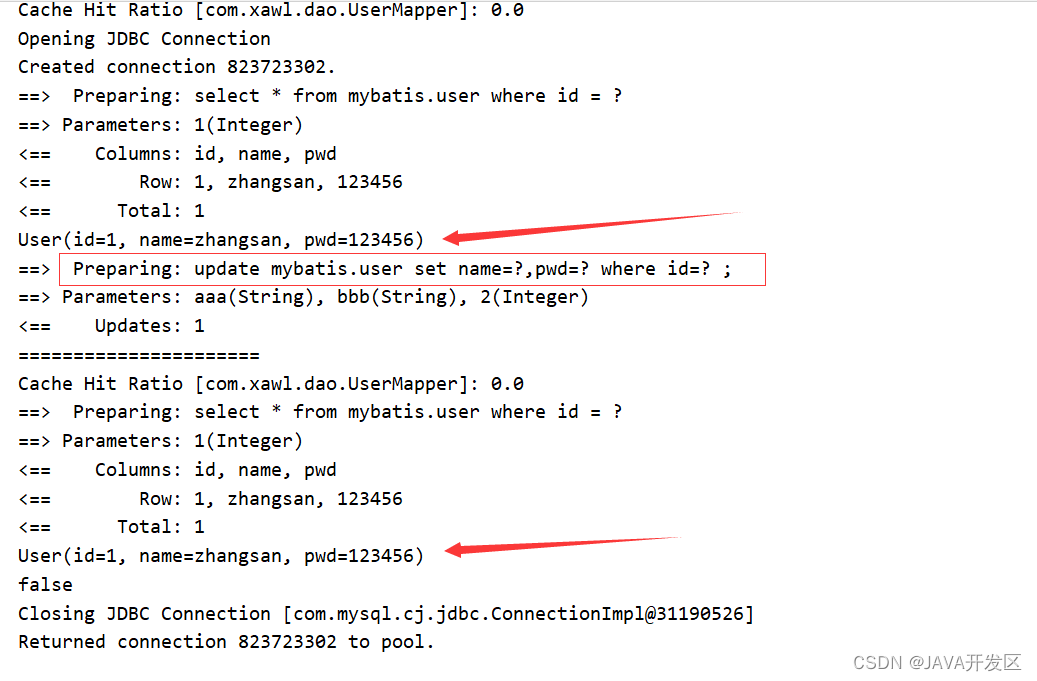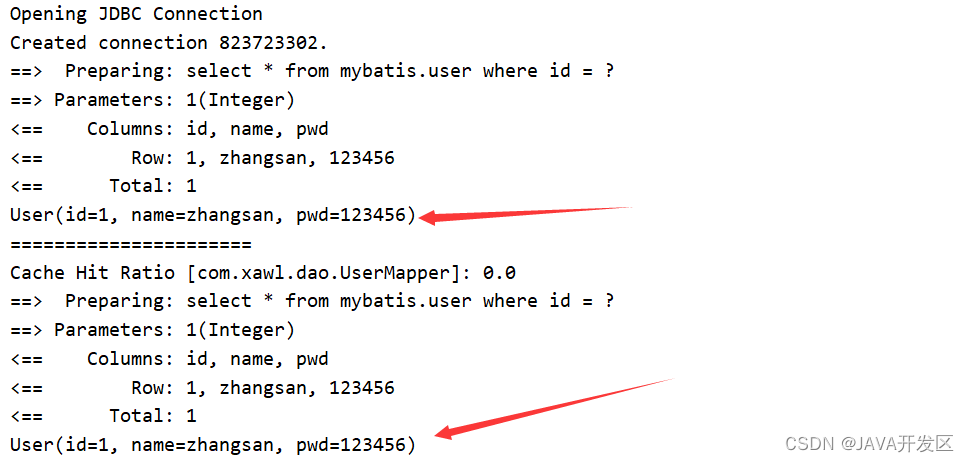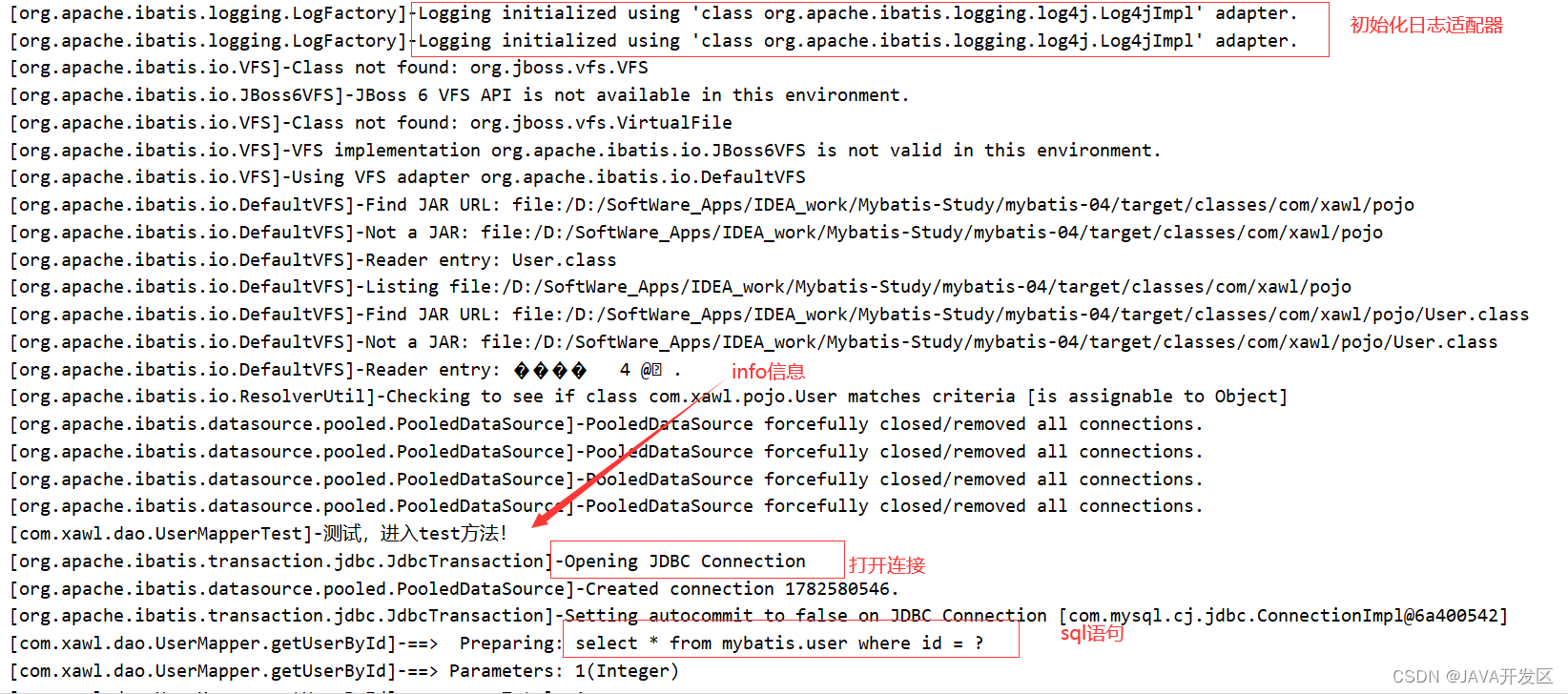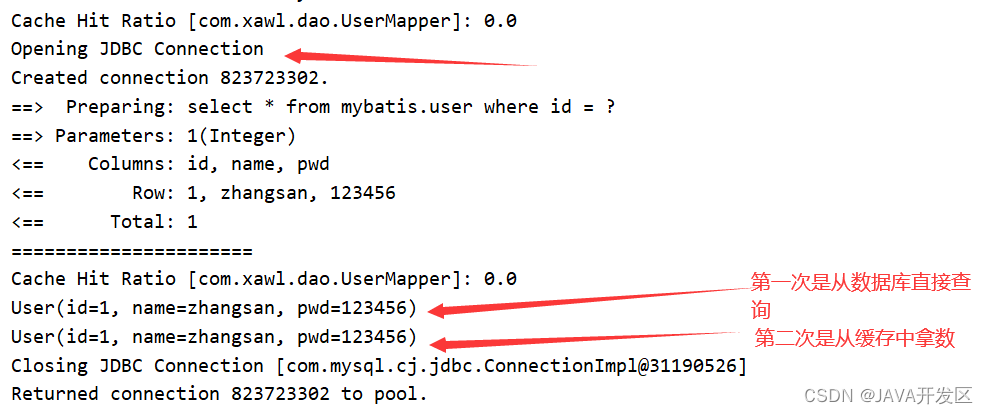SSM笔记之MyBatis
一、什么是MyBatis?
1.1 简介
MyBatis 是一款优秀的持久层框架,它支持自定义 SQL、存储过程以及高级映射。MyBatis 免除了几乎所有的 JDBC 代码以及设置参数和获取结果集的工作。MyBatis 可以通过简单的 XML 或注解来配置和映射原始类型、接口和 Java POJO(Plain Old Java Objects,普通老式 Java 对象)为数据库中的记录。
1.2 maven仓库
<dependency>
<groupId>org.mybatis</groupId>
<artifactId>mybatis</artifactId>
<version>3.5.6</version>
</dependency>
1.3 为什么需要Mybatis?
- 帮助程序猿将数据存入到数据库中
- 方便
- 传统的JDBC代码太复杂,简化–>框架–>自动化
- 优点:使用的人多!简单
二、入门
思路:搭建环境–>导入Mybatis–>编写代码–>测试
2.1 搭建环境
搭建数据库
新建项目
- 新建一个普通maven父项目
- 删除src目录
- 导入maven依赖
<dependencies>
<!--mysql 驱动-->
<dependency>
<groupId>mysql</groupId>
<artifactId>mysql-connector-java</artifactId>
<version>5.1.47</version>
</dependency>
<!--mybatis-->
<dependency>
<groupId>org.mybatis</groupId>
<artifactId>mybatis</artifactId>
<version>3.5.6</version>
</dependency>
<!--junit-->
<dependency>
<groupId>junit</groupId>
<artifactId>junit</artifactId>
<version>4.12</version>
</dependency>
</dependencies>
2.2 创建一个模块
- 编写mybatis的核心配置文件
mybatis-config.xml:
<?xml version="1.0" encoding="UTF-8" ?>
<!DOCTYPE configuration
PUBLIC "-//mybatis.org//DTD Config 3.0//EN"
"http://mybatis.org/dtd/mybatis-3-config.dtd">
<configuration>
<environments default="development">
<environment id="development">
<transactionManager type="JDBC"/>
<dataSource type="POOLED">
<property name="driver" value="com.mysql.cj.jdbc.Driver"/>
<property name="url" value="jdbc:mysql://localhost:3306/mybatis?useSSL=false&characteEncoding=utf-8"/>
<property name="username" value="root"/>
<property name="password" value="123456"/>
</dataSource>
</environment>
</environments>
<!--注意绑定mapper-->
<mappers>
<mapper resource="com/xawl/dao/UserDao.xml"/>
</mappers>
</configuration>
- 编写mybatis工具类
public class MyBatisUtil {
public static SqlSession getSqlSession() throws IOException {
String resource = "mybatis-config.xml";
InputStream inputStream = Resources.getResourceAsStream(resource);
SqlSessionFactory sqlSessionFactory = new SqlSessionFactoryBuilder().build(inputStream);
return sqlSessionFactory.openSession();
}
}
2.3 编写代码
- 编写实体类
public class User {
private int id;
private String name;
private String pwd;
public User(){}
public User(int id, String name, String pwd) {
this.id = id;
this.name = name;
this.pwd = pwd;
}
@Override
public String toString() {
return "User{" +
"id=" + id +
", name='" + name + '\'' +
", pwd='" + pwd + '\'' +
'}';
}
public int getId() {
return id;
}
public void setId(int id) {
this.id = id;
}
public String getName() {
return name;
}
public void setName(String name) {
this.name = name;
}
public String getPwd() {
return pwd;
}
public void setPwd(String pwd) {
this.pwd = pwd;
}
}
- dao接口
public interface UserDao {
List<User> selectAll();
}
- 接口实现类由原来的UserDaoImpl转变成一个Mapper配置文件。
<?xml version="1.0" encoding="UTF-8" ?>
<!DOCTYPE mapper
PUBLIC "-//mybatis.org//DTD Config 3.0//EN"
"http://mybatis.org/dtd/mybatis-3-mapper.dtd">
<!--注意添加namespace-->
<mapper namespace="com.xawl.dao.UserDao">
<!--resultType 需要写全名称-->
<select id="selectAll" resultType="com.xawl.pojo.User">
select * from mybatis.user
</select>
</mapper>
2.4 测试
注意点:
org.apache.ibatis.binding.BindingException: Type interface com.kuang.dao.UserDao is not known to the MapperRegistry.
MapperRegistry是什么?
核心配置文件中注册mappers
- junit测试
public class MyTest {
@Test
public void test() throws IOException {
SqlSession sqlSession = MyBatisUtil.getSqlSession();
UserDao mapper = sqlSession.getMapper(UserDao.class);
List<User> users = mapper.selectAll();
for (User user : users) {
System.out.println(user);
}
sqlSession.close();
}
}
可能遇到的问题:
- 配置文件没有注册;
- 绑定接口错误;
- 方法名不对;
- 返回类型不对;
- Maven导出资源问题。
- 报错序列化UTF-8问题(刷新maven或者修改xml的的一行代码UTF-8改为UTF8)
三、CRUD
3.1 namespace
namespace中的包名要和Dao/Mapper接口的包名一致!
3.2 select
选择,查询语句;
id:就是对应的namespace中的方法名;
resultType:Sql语句执行的返回值!
parameterType:参数类型!
- 编写接口
//根据id查询用户
User getUserById(int id);
- 编写对应的mapper中的sql语句
<select id="getUserById" parameterType="int" resultType="com.kuang.pojo.User">
select * from mybatis.user where id = #{id}
</select>
3.测试
@Test
public void getUserById(){
SqlSession sqlSession = MyBatisUtil.getSqlSession();
UserMapper mapper = sqlSession.getMapper(UserMapper.class);
User user = mapper.getUserById(1);
System.out.println(user);
//关闭SqlSession
sqlSession.close();
}
3.3 Insert
<insert id="addUser" parameterType="com.kuang.pojo.User">
insert into mybatis.user (id,name,pwd) values (#{id},#{name},#{pwd})
</insert>
3.4 Update
<update id="updateUser" parameterType="com.kuang.pojo.User">
update mybatis.user set name=#{name},pwd=#{pwd} where id = #{id}
</update>
3.5 Delete
<delete id="deleteUser" parameterType="int">
delete from mybatis.user where id = #{id}
</delete>
注意点:
- 增删改需要提交事务!
- 标签不要匹配错!
- resource绑定mapper,需要使用路径!
- 程序配置文件必须符合规范!
- NullPointerException,没有注册到资源!
- maven资源没有导出问题!
3.7 万能Map
假设,我们的实体类,或者数据库中的表,字段或者参数过多,我们应当考虑使用Map!
//万能的Map
int addUser2(Map<String,Object> map);
<!--对象中的属性,可以直接取出来 传递map的key-->
<insert id="addUser2" parameterType="map">
insert into mybatis.user (id,pwd) values (#{userid},#{password})
</insert>
@Test
public void addUser2(){
SqlSession sqlSession = MybatisUtils.getSqlSession();
UserMapper mapper = sqlSession.getMapper(UserMapper.class);
Map<String,Object> map = new HashMap<String, Object>();
map.put("userid",4);
map.put("password","123321");
mapper.addUser2(map);
sqlSession.commit();
sqlSession.close();
}
Map传递参数,直接在sql中取出key即可!【parameterType=“map”】
对象传递参数,直接在sql中取对象的属性即可!【parameterType=“Object”】
只有一个基本类型参数的情况下,可以直接在sql中取到!
多个参数用Map,或者注解!
3.8 模糊查询
- java代码执行的时候,传递通配符% %
List<User> userList = mapper.getUserLike("%李%");
- 在sql拼接中使用通配符!(推荐)
select * from mybatis.user where name like "%"#{value}"%"
四、XML配置解析
4.1 核心配置文件
mybatis-config.xml
MyBatis的配置文件包含了会深深影响MyBatis行为的设置和属性信息。
configuration(配置)
properties(属性)
settings(设置)
typeAliases(类型别名)
typeHandlers(类型处理器)
objectFactory(对象工厂)
plugins(插件)
environments(环境配置)
environment(环境变量)
transactionManager(事务管理器)
dataSource(数据源)
databaseIdProvider(数据库厂商标识)
mappers(映射器)
4.2 环境配置(environments)
Mybatis可以配置成适应多种环境
不过要记住:尽管可以配置多个环境,但每个SqlSessionFactory实例只能选择一种环境。
学会使用配置多套运行环境!
Mybatis默认的事务管理器就是JDBC,连接池:POOLED
4.3 属性(properties)
我们可以通过properties属性来实现引用配置文件
这些属性都是可外部配置且可动态替换的,既可以在典型的Java属性文件中配置,亦可通过properties元素的子元素来传递。【db.properties】
编写一个配置文件
db.properties
driver=com.mysql.jdbc.Driver
url=jdbc:mysql://localhost:3306/mybatis?useSSL=false&useUnicode=true&characterEncoding=UTF-8
username=root
password=123456
在核心配置文件中映入
<!--引入外部配置文件-->
<properties resource="db.properties">
<property name="username" value="root"/>
<property name="pwd" value="123123"/>
</properties>
可以直接引入外部文件
可以在其中增加一些属性配置
如果两个文件有同一个字段,优先使用外部配置文件的!
4.4 类型别名(typeAliases)
类型别名是为Java类型设置一个短的名字。
存在的意义仅在于用来减少类完全限定名的冗余。
- typeAlias
<!--可以给实体类起别名-->
<typeAliases>
<typeAlias type="com.kuang.pojo.User" alias="User" />
</typeAliases>
- package
也可以指定一个包名,MyBatis会在包名下面搜索需要的JavaBean,比如:
扫描实体类的包,它的默认别名就为这个类的类名,首字母小写!
<!--可以给实体类起别名-->
<typeAliases>
<package name="com.kuang.pojo"/>
</typeAliases>
在实体类比较少的时候,使用第一种方式。
如果实体类十分多,建议使用第二种。
第一种可以DIY别名,第二种则不行,如果非要改,需要在实体上增加注解
@Alias("user")
//实体类
public class User {}
4.5 设置
这是MyBatis中极为重要的调整设置,它们会改变MyBatis的运行时行为。
<settings>
<!--开启缓存-->
<setting name="cacheEnabled" value="true"/>
<!--懒加载-->
<setting name="lazyLoadingEnabled" value="true"/>
<!--开启驼峰命名自动映射-->
<setting name="mapUnderscoreToCamelCase" value="false"/>
<!--指定 MyBatis 所用日志的具体实现-->
<setting name="logImpl" value="STDOUT_LOGGING "/>
</settings>
4.6 其他配置
- typeHandlers(类型处理器)
- objectFactory(对象工厂)
- plugins(插件)
- mybatis-generator-core
- mybatis-plus
- 通用mapper
4.7 映射器(mappers)
MapperRegistry:注册绑定我们的Mapper文件;
方式一:【推荐使用】
<!--每一个Mapper.xml都需要在Mybatis核心配置文件中注册!-->
<mappers>
<mapper resource="com/kuang/dao/UserMapper.xml"/>
</mappers>
方式二:使用class文件绑定注册
<!--每一个Mapper.xml都需要在Mybatis核心配置文件中注册!-->
<mappers>
<mapper class="com.kuang.dao.UserMapper"/>
</mappers>
方式三:使用扫描包进行注入绑定
<!--每一个Mapper.xml都需要在Mybatis核心配置文件中注册!-->
<mappers>
<package name="com.kuang.dao"/>
</mappers>
注意点:
接口和它的Mapper配置文件必须同名!
接口和它的Mapper配置文件必须在同一个包下!
4.8 生命周期和作用域

生命周期和作用域是至关重要的,因为错误的使用会导致非常严重的并发问题。
- SqlSessionFactoryBuilder: 一旦创建了 SqlSessionFactory,就不再需要它了。
局部变量 - SqlSessionFactory:说白就是可以想象为:数据库连接池。
SqlSessionFactory 一旦被创建就应该在应用的运行期间一直存在,没有任何理由丢弃它或重新创建另一个实例。
SqlSessionFactory 的最佳作用域是应用作用域。
最简单的就是使用单例模式或者静态单例模式。 - SqlSession:连接到连接池的一个请求!
SqlSession 的实例不是线程安全的,因此是不能被共享的,所以它的最佳的作用域是请求或方法作用域。
用完后需要赶紧关闭,否则资源被占用!
![在这里插入图片描述]()
这里的每一个Mapper,就代表一个具体的业务!
五、结果集映射ResultMap
解决属性名和字段名不一致的问题
5.1 问题
数据库中的字段
新建一个项目,拷贝之前的,测试实体类字段不一致的情况
public class User {
private int id;
private String name;
private String password;
}
测试出现问题
password和pwd对应不上
// select * from mybatis.user where id = #{id}
// 类型处理器
// select id,name,pwd from mybatis.user where id = #{id}
解决方法:
- 起别名
<select id="getUserById" parameterType="int" resultType="user">
select id,name,pwd as password from mybatis.user where id = #{id}
</select>
- resultMap解决
5.2 resultMap
结果集映射
<!-- 结果集映射
id name pwd
id name password
-->
<resultMap id="UserMap" type="User">
<!--column数据库中的字段,property实体类中的属性-->
<result column="id" property="id" />
<result column="name" property="name" />
<result column="pwd" property="password" />
</resultMap>
<select id="getUserById" parameterType="int" resultMap="UserMap">
select * from mybatis.user where id = #{id}
</select>
resultMap 元素是 MyBatis 中最重要最强大的元素。
ResultMap 的设计思想是,对简单的语句做到零配置,对于复杂一点的语句,只需要描述语句之间的关系就行了。
ResultMap 的优秀之处——你完全可以不用显式地配置它们。
如果这个世界总是这么简单就好了。
六、日志
6.1 日志工厂
如果一个数据库操作出现了异常,我们需要排错。日志就是最好的助手!
曾经:sout、debug
现在:日志工厂!
SLF4J
LOG4J 【掌握】
LOG4J2
JDK_LOGGING
COMMONS_LOGGING
STDOUT_LOGGING【掌握】
NO_LOGGING
在Mybatis中具体使用哪一个日志实现,在设置中设定!
STDOUT_LOGGING标准日志输出
在mybatis-config.xml核心配置文件中,配置我们的日志!
<settings>
<setting name="logImpl" value="STDOUT_LOGGING"/>
</settings>
6.2 Log4j
什么是Log4j?
Log4j是Apache的一个开源项目,通过使用Log4j,我们可以控制日志信息输送的目的地是控制台、文件、GUI组件
我们也可以控制每一条日志的输出格式;
通过定义每一条日志信息的级别,我们能够更加细致地控制日志的生成过程。
可以通过一个配置文件来灵活地进行配置,而不需要修改应用的代码。
- 先在pom.xml文件中导入log4j的依赖包
<dependencies>
<!-- https://mvnrepository.com/artifact/log4j/log4j -->
<dependency>
<groupId>log4j</groupId>
<artifactId>log4j</artifactId>
<version>1.2.17</version>
</dependency>
</dependencies>
- 在resources文件夹下建立log4j.properties文件进行配置
#将等级为DEBUG的日志信息输出到console和file这两个目的地,console和file的定义在下面的代码
log4j.rootLogger = DEBUG,console ,file
#控制台输出的相关设置
log4j.appender.console = org.apache.log4j.ConsoleAppender
log4j.appender.console.Target = System.out
log4j.appender.console.Threshold = DEBUG
log4j.appender.console.layout = org.apache.log4j.PatternLayout
log4j.appender.console.layout.ConversionPattern = [%c]-%m%n
#文件输出的相关设置
log4j.appender.file = org.apache.log4j.RollingFileAppender
log4j.appender.file.File = ./log/kuang.log
log4j.appender.file.MaxFileSize = 10mb
log4j.appender.file.Threshold = DEBUG
log4j.appender.file.layout = org.apache.log4j.PatternLayout
log4j.appender.file.layout.ConversionPattern = [%p][%d{yy-MM-dd}][%c]%m%n
#日志输出级别
log4j.logger.org.mybatis=DEBUG
log4j.logger.java.sql=DEBUG
log4j.logger.java.sql.Statement=DEBUG
log4j.logger.java.sql.ResultSet=DEBUG
log4j.logger.java.sql.PreparedStatement=DEBUG
- 在mybatis-config.xml核心配置文件中,配置log4j为日志的实现!
<settings>
<setting name="logImpl" value="LOG4J"/>
</settings>
- Log4j的使用,直接测试运行
![在这里插入图片描述]()
简单使用
在要使用Log4j的测试类中,导入包import org.apache.log4j.Logger;
日志对象,参数为当前类的class
static Logger logger = Logger.getLogger(UserDaoTest.class);
日志级别
logger.info("info:进入了testLog4j");
logger.debug("DEBUG:进入了testLog4j");
logger.error("erro:进入了testLog4j");
之后可在log文件夹中查看日志文件信息
七、分页
思考:为什么要分页!
减少数据的处理量
7.1 使用Limit分页
<!--语法:SELECT * from user limit startIndex,pageSize-->
SELECT * from user limit 3 #[0,n]
使用Mybatis实现分页,核心SQL
接口
//分页
List<User> getUserByLimit(Map<String,Integer> map);
Mapper.xml
<!--分页-->
<select id="getUserByLimit" parameterType="map" resultMap="UserMap">
select * from mybatis.user limit #{startIndex},#{pageSize}
</select>
测试
@Test
public void getUserByLimit(){
SqlSession sqlSession = MybatisUtils.getSqlSession();
UserMapper mapper = sqlSession.getMapper(UserMapper.class);
HashMap<String, Integer> map = new HashMap<String, Integer>();
map.put("startIndex",0);
map.put("pageSize",2);
List<User> userList = mapper.getUserByLimit(map);
for (User user : userList) {
System.out.println(user);
}
sqlSession.close();
}
7.2 RowBounds分页
不再使用SQL实现分页
接口
//分页2
List<User> getUserByRowBounds();
Mapper.xml
<!-- 分页2-->
<select id="getUserByRowBounds" resultMap="UserMap">
select * from mybatis.user
</select>
测试
@Test
public void getUserByRowBounds(){
SqlSession sqlSession = MybatisUtils.getSqlSession();
//RowBounds实现
RowBounds rowBounds = new RowBounds(0, 2);
//通过java代码层面实现分页
List<User> userList = sqlSession.selectList("com.kuang.dao.UserMapper.getUserByRowBounds",null,rowBounds);
for (User user : userList) {
System.out.println(user);
}
sqlSession.close();
}
7.3 分页插件
了解即可,使用时,需要知道是什么东西!
MyBatis分页插件(MyBatis PageHelper)
八、使用注解开发
8.1 面向接口编程
之前学过面向对象编程,也学习过接口,但在真正的开发中,很多时候会选择面向接口编程。
根本原因:解耦,可拓展,提高复用,分层开发中,上层不用管具体的实现,大家都遵守共同的标准,使得开发变得容易,规范性更好
在一个面向对象的系统中,系统的各种功能是由许许多多的不同对象协作完成的。在这种情况下,各个对象内部是如何实现自己的,对系统设计人员来讲就不那么重要了;
而各个对象之间的协作关系则成为系统设计的关键。小到不同类之间的通信,大到各模块之间的交互,在系统设计之初都是要着重考虑的,这也是系统设计的主要工作内容。面向接口编程就是指按照这种思想来编程。
8.2 使用注解开发
- 注解在UserMapper接口上实现,并删除UserMapper.xml文件
@Select("select * from user")
List<User> getUsers();
- 需要在mybatis-config.xml核心配置文件中绑定接口
<!--绑定接口!-->
<mappers>
<mapper class="com.kuang.dao.UserMapper" />
</mappers>
- 测试
@Test
public void getUsers(){
SqlSession sqlSession = MybatisUtils.getSqlSession();
UserMapper mapper = sqlSession.getMapper(UserMapper.class);
List<User> users = mapper.getUsers();
for (User user : users) {
System.out.println(user);
}
sqlSession.close();
}
本质:反射机制实现
底层:动态代理!
8.3 CRUD
在MybatisUtils工具类创建的时候实现自动提交事务!openSession(true)
public static SqlSession getSqlSession(){
return sqlSessionFactory.openSession(true);
}
- 编写接口,增加注解
public interface UserMapper {
@Select("select * from user")
List<User> getUsers();
//方法存在多个参数,所有参数前面必须加上@Param("id")注解
@Select("select * from user where id=#{id}")
User getUserById(@Param("id") int id);
@Insert("insert into user (id,name,pwd) values(#{id},#{name},#{password})")
int addUser(User user);
@Update("update user set name=#{name},pwd=#{password} where id=#{id}")
int updateUser(User user);
@Delete("delete from user where id = #{uid}")
int deleteUser(@Param("uid") int id);
}
测试类
【注意:我们必须要将接口注册绑定到我们的核心配置文件中!】
关于@Param()注解
- 基本类型的参数或者String类型,需要加上
- 引用类型不需要加
- 如果只有一个基本类型的话,可以忽略,但是建议都加上!
- 我们在SQL中引用的就是我们这里的@Param(“”)中设定的属性名!
- #{}和${}区别
九、多对一处理
多对一:
多个学生,对应一个老师
对于学生而言,关联–多个学生,关联一个老师【多对一】
对于老师而言,集合–一个老师,有很多个学生【一对多】
SQL语句:
CREATE TABLE `teacher` (
`id` INT(10) NOT NULL,
`name` VARCHAR(30) DEFAULT NULL,
PRIMARY KEY (`id`)
)ENGINE = INNODB DEFAULT CHARSET=utf8
INSERT INTO teacher(`id`,`name`) VALUES (1,'秦老师');
CREATE TABLE `student` (
`id` INT(10) NOT NULL,
`name` VARCHAR(30) DEFAULT NULL,
`tid` INT(10) DEFAULT NULL,
PRIMARY KEY (`id`),
KEY `fktid`(`tid`),
CONSTRAINT `fktid` FOREIGN KEY (`tid`) REFERENCES `teacher` (`id`)
)ENGINE = INNODB DEFAULT CHARSET=utf8
INSERT INTO `student`(`id`,`name`,`tid`) VALUES ('1','小明','1');
INSERT INTO `student`(`id`,`name`,`tid`) VALUES ('2','小红','1');
INSERT INTO `student`(`id`,`name`,`tid`) VALUES ('3','小张','1');
INSERT INTO `student`(`id`,`name`,`tid`) VALUES ('4','小李','1');
INSERT INTO `student`(`id`,`name`,`tid`) VALUES ('5','小王','1');
- 测试环境搭建
- 导入Lombok
- 新建实体类Teacher,Student
- 建立Mapper接口
- 建立Mapper.XML文件
- 在核心配置文件中绑定注册我们的Mapper接口或者文件!【方式很多,随心选】
- 测试查询是否能够成功!
- 按照结果嵌套处理 (表连接)
<!--按照结果嵌套处理 -->
<select id="getStudent2" resultMap="StudentTeacher2">
select s.id sid,s.name sname,t.name tname
from mybatis.student s,mybatis.teacher t
where s.tid = t.id
</select>
<resultMap id="StudentTeacher2" type="Student">
<result property="id" column="sid"/>
<result property="name" column="sname"/>
<association property="teacher" javaType="Teacher">
<result property="name" column="tname"/>
</association>
</resultMap>
- 按照查询嵌套处理 (where子查询)
<!--
思路:
1.查询所有的学生信息
2.根据查询出来的学生的tid,寻找对应的老师! 子查询-->
<select id="getStudent" resultMap="StudentTeacher">
select * from mybatis.student
</select>
<resultMap id="StudentTeacher" type="Student">
<result property="id" column="id"/>
<result property="name" column="name"/>
<!-- 复杂的属性,我们需要单独处理 对象:association 集合:collection -->
<association property="teacher" column="tid" javaType="Teacher" select="getTeacher"/>
</resultMap>
<select id="getTeacher" resultType="Teacher">
select * from mybatis.teacher where id = #{id}
</select>
十 、一对多处理
比如:一个老师拥有多个学生!
对于老师而言,就是一对多的关系!
环境搭建
环境搭建,和刚才一样
实体类:
@Data
public class Student {
private int id;
private String name;
private int tid;
}
@Data
public class Teacher {
private int id;
private String name;
//一个老师拥有多个学生
private List<Student> students;
}
- 按照结果嵌套处理
<!-- 按结果嵌套查询-->
<select id="getTeacher" resultMap="TeacherStudent">
SELECT s.id sid,s.name sname,t.name tname,t.id,tid
from student s,teacher t
where s.tid = t.id and t.id = #{tid}
</select>
<resultMap id="TeacherStudent" type="Teacher">
<result property="id" column="tid"/>
<result property="name" column="tname"/>
<!-- 复杂的属性,我们需要单独处理 对象:association 集合:collection
javaType="" 指定属性的类型!
集合中的泛型信息,我们使用ofType获取
-->
<collection property="students" ofType="Student">
<result property="id" column="sid"/>
<result property="name" column="sname"/>
<result property="tid" column="tid"/>
</collection>
</resultMap>
- 按照查询嵌套处理
<select id="getTeacher2" resultMap="TeacherStudent2">
select * from mybatis.teacher where id = #{tid}
</select>
<resultMap id="TeacherStudent2" type="Teacher">
<collection property="students" javaType="ArrayList" ofType="Student" select="getStudentByTeacherId" column="id"/>
</resultMap>
<select id="getStudentByTeacherId" resultType="Student">
select * from mybatis.student where tid = #{tid}
</select>
小结:
- association和collection
关联-association【多对一】
集合-collection【一对多】 - javaType & ofType
javaType 用来指定实体类中属性的类型
ofType 用来指定映射到List或者集合中的pojo类型,泛型中的约束类型!
注意点:
- 保证SQL的可读性,尽量保证通俗易懂
- 注意一对多和多对一中,属性名和字段的问题!
- 如果问题不好排查错误,可以使用日志,建议使用Log4j
面试高频
1.Mysql引擎
2.InnoDB底层原理
3.索引
4.索引优化
十一、动态SQL
什么是动态SQL:动态SQL就是 指根据不同的条件生成不同的SQL语句
利用动态SQL这一特性可以彻底摆脱这种痛苦。
在 MyBatis 之前的版本中,需要花时间了解大量的元素。借助功能强大的基于 OGNL 的表达式,MyBatis 3 替换了之前的大部分元素,大大精简了元素种类,现在要学习的元素种类比原来的一半还要少。
if
choose (when, otherwise)
trim (where, set)
foreach
- 搭建环境
CREATE TABLE `blog`(
`id` VARCHAR(50) NOT NULL COMMENT '博客id',
`title` VARCHAR(100) NOT NULL COMMENT '博客标题',
`author` VARCHAR(30) NOT NULL COMMENT '博客作者',
`create_time` DATETIME NOT NULL COMMENT '创建时间',
`views` INT(30) NOT NULL COMMENT '浏览量'
)ENGINE=INNODB DEFAULT CHARSET=utf8
- 创建一个基础工程
- 导包
- 编写配置文件
- 编写实体类
@Data
public class Blog {
private String id;
private String title;
private String author;
private Date createTime; //属性名和字段名不一致
private int views;
}
- 编写实体类对应Mapper接口和Mapper.XML文件
- IF
<select id="queryBlogIF" parameterType="map" resultType="Blog">
select * from mybatis.blog where 1=1
<if test="title != null">
and title = #{title}
</if>
<if test="author != null">
and author = #{author}
</if>
</select>
- choose (when, otherwise)
<select id="queryBlogChoose" parameterType="map" resultType="Blog">
select * from mybatis.blog
<where>
<choose>
<when test="title != null">
title = #{title}
</when>
<when test="author != null">
and author = #{author}
</when>
<otherwise>
and views = #{views}
</otherwise>
</choose>
</where>
</select>
- trim (where, set)
<select id="queryBlogIF" parameterType="map" resultType="Blog">
select * from mybatis.blog
<where>
<if test="title != null">
and title = #{title}
</if>
<if test="author != null">
and author = #{author}
</if>
</where>
</select>
<update id="updateBlog" parameterType="map">
update mybatis.blog
<set>
<if test="title != null">
title = #{title},
</if>
<if test="author != null">
author = #{author}
</if>
</set>
where id = #{id}
</update>
所谓的动态SQL,本质还是SQL语句,只是我们可以在SQL层面,去执行一个逻辑代码
- Foreach
动态 SQL 的另一个常见使用场景是对集合进行遍历(尤其是在构建 IN 条件语句的时候)。
foreach 元素的功能非常强大,它允许你指定一个集合,声明可以在元素体内使用的集合项(item)和索引(index)变量。它也允许你指定开头与结尾的字符串以及集合项迭代之间的分隔符。这个元素也不会错误地添加多余的分隔符,看它多智能!
提示你可以将任何可迭代对象(如 List、Set 等)、Map 对象或者数组对象作为集合参数传递给 foreach。当使用可迭代对象或者数组时,
index 是当前迭代的序号,
item 的值是本次迭代获取到的元素。当使用 Map 对象(或者 Map.Entry 对象的集合)时,index 是键,item 是值。
<!--select * from blog where 1=1 and (id=1 or id=2 or id=3)
我们现在传递一个万能的map,这map中可以存在一个集合!
-->
<select id="queryBlogForeach" parameterType="map" resultType="Blog">
select * from mybatis.blog
<where>
<foreach collection="ids" item="id" open="and (" close=")" separator="or">
id = #{id}
</foreach>
</where>
</select>
动态SQL就是在拼接SQL语句,我们只要保证SQL的正确性,按照SQL的格式,去排列组合就可以了。
建议:
先在Mysql中写出完整的SQL,再对应的去修改成我们的动态SQL实现通用即可!
SQL片段
有的时候,我们可以能会将一些功能的部分抽取出来,方便复用!
使用SQL标签抽取公共的部分
<sql id="if-title-author">
<if test="title != null">
title = #{title}
</if>
<if test="author != null">
and author = #{author}
</if>
</sql>
在需要使用的地方使用Include标签引用即可
<select id="queryBlogIF" parameterType="map" resultType="Blog">
select * from mybatis.blog
<where>
<include refid="if-title-author"></include>
</where>
</select>
注意事项:
- 最好基于单表来定义SQL片段!
- 不要存在where标签
十二、缓存
12.1 简介
- 什么是缓存[Cache]?
存在内存中的临时数据。
将用户经常查询的数据放在缓存(内存)中,用户去查询数据就不用从磁盘上(关系型数据库查询文件)查询,从缓存中查询,从而提高查询效率,解决了高并发系统的性能问题。 - 为什么使用缓存?
减少和数据库的交互次数,减少系统开销,提高系统效率。 - 什么样的数据能使用缓存?
经常查询并且不经常改变的数据。【可以使用缓存】
12.2 Mybatis缓存
Mybatis包含一个非常强大的查询缓存特性,它可以非常方便地定制和配置缓存。缓存可以极大的提升查询效率。
Mybatis系统中默认定义了两级缓存:一级缓存和二级缓存
默认情况下,只有一级缓存开启。(SqlSession级别的缓存,也称为本地缓存)
二级缓存需要手动开启和配置,它是基于namespace级别的缓存。
为了提高扩展性,Mybatis定义了缓存接口Cache,我们可以通过实现Cache接口来自定义二级缓存。
12.3 一级缓存
一级缓存也叫本地缓存:
与数据库同一次会话期间查询到的数据会放在本地缓存中。
以后如果需要获取相同的数据,直接从缓存中拿,没必要再去查询数据库
测试步骤:
- 开启日志!
- 测试在一个Session中查询两次相同记录
- 查看日志输出
sql语句只执行一次
![在这里插入图片描述]()
缓存失效的情况:
-
查询不同的东西;
-
增删改操作,可能会改变原来的数据,所以必定会刷新缓存!

-
查询不同的Mapper.xml
-
手动清理缓存!clearCache()

小结:一级缓存默认是开启的,只在一次SqlSession中有效,也就是拿到连接到关闭连接这个区间段!
一级缓存相当于一个Map。
12.4 二级缓存
二级缓存也叫全局缓存,一级缓存作用域太低了,所以诞生了二级缓存;
基于namespace级别的缓存,一个命名空间,对应一个二级缓存;
工作机制
一个会话查询一条数据,这个数据就会被放在当前会话的一级缓存中;
如果当前会话关闭了,这个会话对应的一级缓存就没了;但是我们想要的是,会话关闭了,一级缓存中的数据被保存到二级缓存中;
新的会话查询信息,就可以从二级缓存中获取内容;
不同的mapper查出的数据就会放在自己对应的缓存(map)中;
步骤:
- 在mybatis-config.xml开启全局缓存
<!--显示的开启全局缓存-->
<setting name="cacheEnabled" value="true"/>
- 在要使用二级缓存的Mapper中开启
<!--在当前Mapper.xml中使用二级缓存-->
<cache/>
也可以自定义参数
<!--在当前Mapper.xml中使用二级缓存-->
<cache
eviction="FIFO"
flushInterval="60000"
size="512"
readOnly="true"/>
- 测试
问题:如果没有自定义参数,则会报错,我们需要将实体类序列化!
Cause: java.io.NotSerializableException: com.kuang.pojo.User
小结:
- 只要开启了二级缓存,在同一个Mapper下就有效;
- 所有的数据都会先放在一级缓存中;
- 只有当会话提交或者关闭的时候,才会提交到二级缓存中!
12.5 缓存原理

12.6 自定义缓存-ehcache
-
Ehcache是一种广泛使用的开源Java分布式缓存,主要面向通用缓存。
-
要在程序中使用ehcache,先要导包!
-
在mapper中指定使用我们的ehcache缓存实现!
-
目前:Redis数据库来做缓存!K-V






 浙公网安备 33010602011771号
浙公网安备 33010602011771号